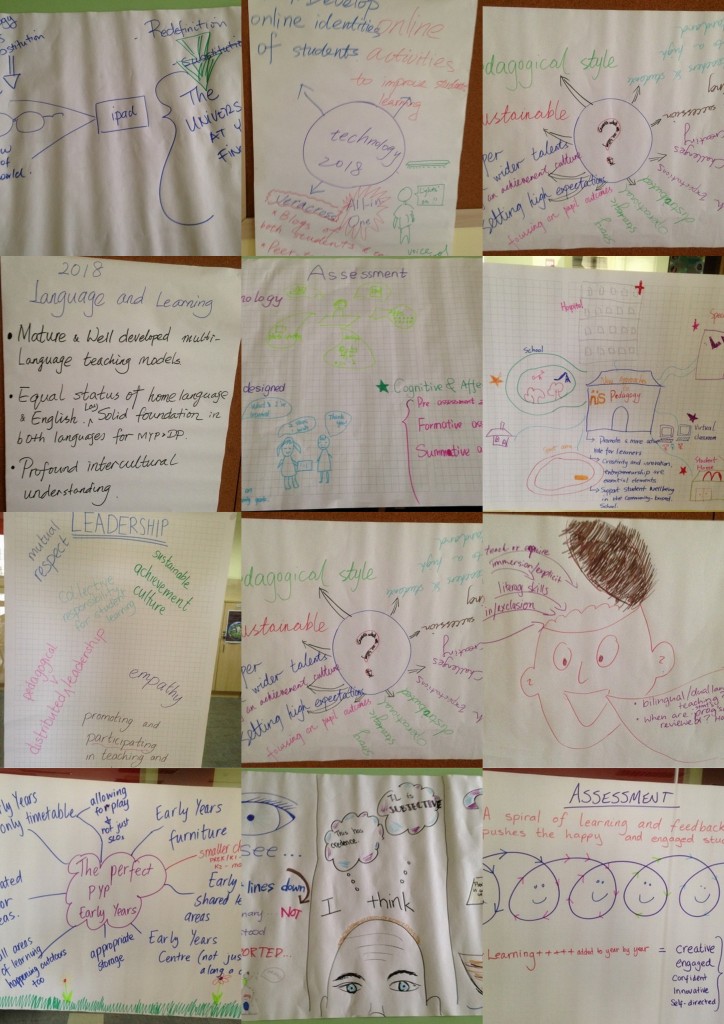Nanjing International School shares how their PYP staff put together their feedback on the consultation paper by using a thinking strategy.
Schools have time until 31 May 2014 to send their thoughts and comments on the key themes of the PYP review.
“The ongoing PYP review will have an impact upon all of us in the IB World so it is important that teachers and school’s reflect upon the themes. Even for those teachers who might be moving out of the PYP, the themes provide an important point of reflection upon their own professional practice.
For this reason we devoted a staff meeting to reviewing the themes in mid-March.
The aims of the meeting were:
- to familiarize staff with the key themes
- to reflect upon current PYP practice in the themes
- to envisage how the themes might be developed
- to have time to discuss the themes and share professional practice in cross grade level groups.
The meeting was organized in the following manner:
Staff were assigned to a group of 4 – 5 people representing a cross grade spread as well as trying to put people together who don’t normally get the chance to share professional knowledge. Some themes had two groups reviewing them.
Each group was given one of the themes to read and discuss using the ‘Last Word Protocol’. For those of you unfamiliar with it the Last Word Protocol is a highly effective way to delve deeply into texts.
Last word Protocol
All members of the table group read a selected piece of text. As they read they highlight key ideas and concepts. Once all members of the group have finished reading:
- Each team member is assigned a number.
- Team member 1 shares a highlighted item with the group, but makes no further comment.
- Going round robin, each team member comments on the initial person’s selection.
- There is no cross talk and no interruptions.
- The initial person reflects on his or her highlighted item, having the “Final Word” after hearing all the other team members’ comments.
- Team member 2 shares a highlighted item but makes no further comment.
- The pattern repeats until everyone has had a turn.
Following this discussion phase, staff were posed the following scenario:
Imagine you go home tonight and exhausted from another staff meeting and wake up in 2018.What does the new PYP framework contain in the area that you looked at that fills you with enthusiasm?
(Record this vision on the paper provided. Use what ever format suits your group).
The idea for this question came from the Dream phase of an Appreciative Inquiry approach.
Staff then went into their groups and returned after 40 minutes to share each others’ work via a gallery walk. Their products are displayed below. It is interesting when reflecting on the assessment theme that only a few groups chose to show their understanding in a purely linguistic manner.
As a kick off of a longer process and to begin a discussion, the session was successful even coming towards the end of a long term. The issues now is how do we as a school, and the PYP programme move forward in ensuring that our dreamed vision of what the PYP can be comes to pass in every PYP school and classroom?”
—
Derek Pinchbeck began his teaching career at an inner city school in the UK. For the last 20 years he has been teaching in International Schools around the world. He began his involvement with the PYP when he moved to Milan, Italy in 2001. Derek is a PYP workshop leader and site visitor. He blogs at Thirst For Thinking.




Thanks for sharing this thoughtful and creative approach to a group review. I’m excited to add some of these dimensions to our own review.